THE GARDEN IN WINTER
Forming Relationships
This may sound crazy but even this far north, winter isn’t a bad time to admire the garden. With leaves and flowers a memory of the past season and a hope for the coming season, the garden is reduced to its bare bones. Not that the wintry scene need be dull or bleak. Good bones give structure to the landscape, knitting it together in some places, dividing it up in others, framing vistas, and providing firm footing for the eyes (figuratively) and feet (literally). Even now.
Three-dimensional forms are what give structure to a landscape. A house usually is the most obvious mass jutting up into space on a property. Too often it’s the only structural element, feebly tied to the landscape with some gumdrop-shaped junipers or yews standing, as if guarding, the foundation.
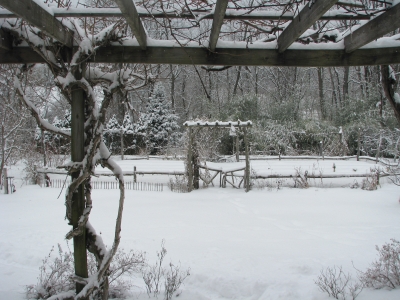 I have effected a relationship between my yard and my house by building a grape arbor out from the rear wall, then enclosing the ground beneath this arbor with a brick terrace (my house is also brick) edged with a low hedge of potentilla. Similarly, the stone wall supporting what previous were slopes at the front and side of my house flow into the landscape with a contiguous stone wall sweeping out across the yard.
I have effected a relationship between my yard and my house by building a grape arbor out from the rear wall, then enclosing the ground beneath this arbor with a brick terrace (my house is also brick) edged with a low hedge of potentilla. Similarly, the stone wall supporting what previous were slopes at the front and side of my house flow into the landscape with a contiguous stone wall sweeping out across the yard.
Defining Areas and Movement
Plants add mass and definition to the landscape only if they are evergreen, sufficiently large, or densely twiggy. Though the line of privets dividing the back portion of my property into two “rooms” are now leafless, their twigs are dense enough to make a billowing, brown swatch in the landscape.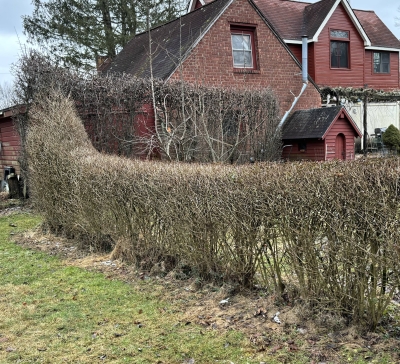
Around the other side of the yard, the limbs and trunk of a honeylocust I planted almost twenty years ago are finally defining the space beneath the spreading branches.
Years ago, I planted a long, double row of dwarf apple trees, with four feet between the trees and fifteen feet between the rows. This small allée curved out of sight, the tree trunks drawing my eyes or my feet along like highway markers to the back of the yard. I’ve since replanted the allée with dwarf pear trees, with similar effect.

The Best Laid Plans; Sometimes There Aren’t
Unlike annual plants, which leave no legacy at the end of the season, trees, hedges, and stone walls make strong, permanent statements, so must be planned as part of some overall design. Every structural element needs a clearly defined purpose before it’s built or planted.
My original vegetable garden looked like it had been plopped down on the ground across an expanse of forty feet of lawn until, after about five years, I decided it needed to be more physically and aesthetically connected to the house. I finally knocked an opening through the back wall of the house, then put in a glass doorway. Standing in my kitchen I can look past my living room, through the doorway, over the arbored terrace, straight out to the garden gate, through the garden path, then out the back garden gate into a mysterious, dark path framed by bamboo and a hemlock and balsam fir tree. (I did plan and plant all that so the path is not all that mysterious — to me, at least.)
“Clearly defined purpose” notwithstanding, I’ve planted more than my share of trees on impulse, and later have had to cut them down or move them to more suitable locations. And that arbor: after even less than a decade it already had suffered numerous readjustments as I added, removed, or just shifted posts, and crosspieces, and changed what plants they were supporting.
Fortunately, the three stone walls I built here all were well-placed. The first one, my first-ever stone wall, is somewhat sloppy and could use an overhaul.
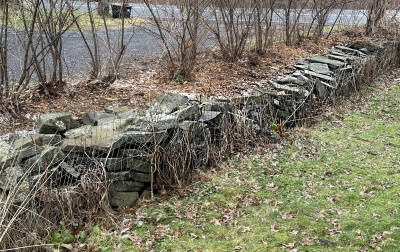
First wall
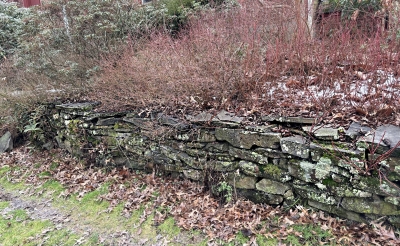
Second wall
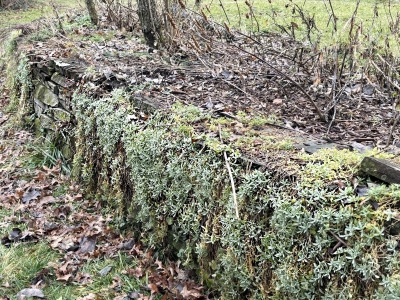
Third wall
Sometimes those impulse plantings have been serendipitous. Year ‘round, I look out my second story bedroom window in the morning to admire the shades of green and varying textures of the bamboo, hemlock, and balsam fir that form the backdrop for my garden. That backdrop extends further along with a stately row of columnar arborvitae, (shielding compost piles) behind which peek out the row of glossy green leaved Meserve hollies.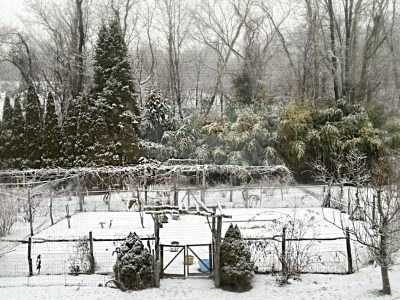
I wish I could say that all that was carefully planned out; it wasn’t. Over the course of many years, I put in one plant, then another and another, not imagining what the big picture would look like.
Take Time
An allée, a billowing hedge, or an arbor doesn’t come into its full glory overnight. Even if almost full-grown plants are set in the ground, it takes some seasons before they snuggle into their surroundings and look truly at home. With time, frost, rain and sun lend a patina to tree trunks, stone walls, and fences. Near the ground, creeping plants lend a gentle embrace.
There’s no way around it — age is needed to bring character to these weighty garden elements. Some aspects of gardening should be long term propositions.


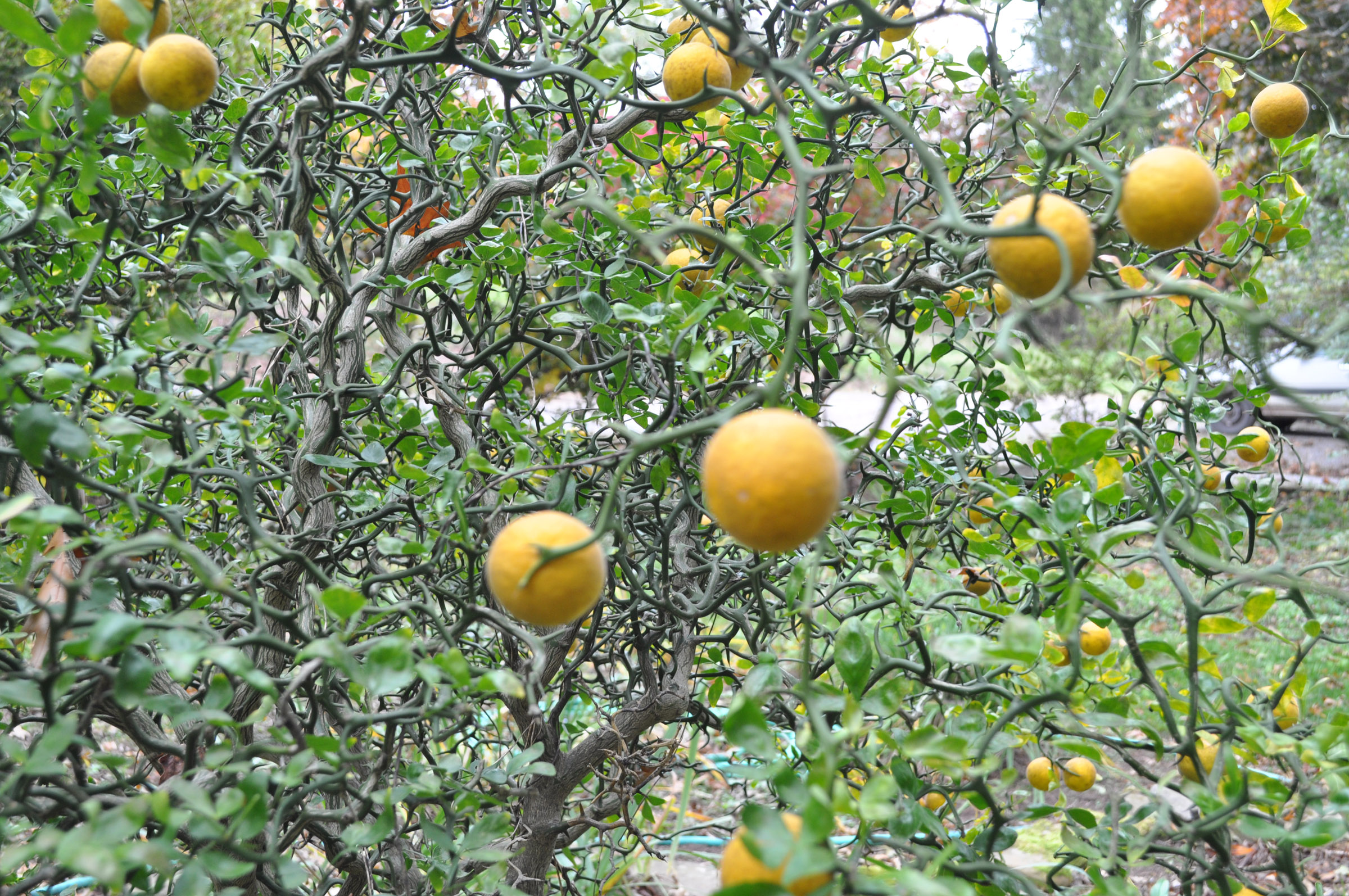

Love this article! As I take over my mother’s garden (4 yrs. ago), I’m starting to put in more than plants; a fountain at my brother’s suggestion, uncovering some stones (by accident!) that look pretty good as they are, where they are. And contemplating other possibilities…. Thanks for the tips & ideas!
Nice. I am blessed/cursed with a lack of any stones at all here so I had to purchase all that I used for walls.
I’m considering some retaining walls, yours look interesting, like stacked shale, maybe? What are they composed of, might I ask? Was any mortar used? Thank you!
– Sabine
Except for my first wall, the others are bluestone, which is the local stone generally used here for walls. No mortar was used.
Thank you for your thoughtful and eloquent observations and helpful gardening advice. I so enjoy your writing and the accompanying photos!
Thanks, that’s always nice to hear.